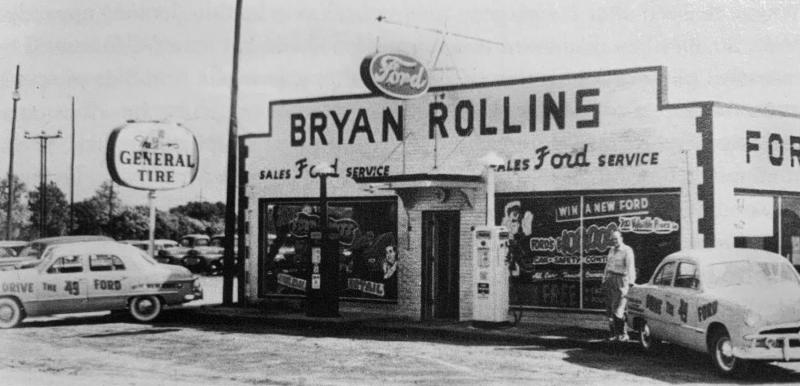In 1945, Isabel Jacob added four very active new people to her life. Her daughter, Kitty, had married John Rollins, an engaging, high-energy WWII factory manager. The couple came with their two children to live with Isabel at her home on Lewes Beach.
Lewes locals weren’t sure what to make of the “poor man from Georgia” who had to live with his mother-in-law. John soon showed them. Ruminating over the need for a local repair shop for his Ford, John leased Isabel’s commercial property in Lewes, obtained a $10,000 loan from Sussex Trust and opened a Ford dealership with his fishing buddy Dory Bryan, a Lewes councilman.
John soon encouraged his brother, Wayne, to join him in Lewes and invest in his plan to grow Ford dealerships across Delmarva. Wayne had been pursuing his interest in radio, which had fascinated him since his youth. In 1949, the Rollins brothers scraped together $12,500, secured another loan and formed Rollins Broadcasting, which Wayne would manage. They then opened WJLW, the first AM radio station in Sussex County.
Within a decade, the Rollins Inc. companies included a regional network of dealerships, ten groundbreaking radio stations (five built around newly popular African American talent), the emerging truck and auto leasing business, billboards in the early ’60s and, by 1964, control of the Orkin Pest Control Company in Atlanta, Georgia.
No one could have guessed the small Rollins Inc. venture started in Lewes would one day become a global $50 billion corporation. But all that was still in the future. Then, in postwar Lewes, it was John and Wayne and one of Wayne’s two sons, nineteen-year-old Randall Rollins.
After graduating high school, Randall moved to Lewes to work at his uncle John’s dealership, where he put undercoating on cars, handled repossessions and drove the wrecker. One day, the tall, handsome southerner met a pretty local girl, Margaret “Peggy” Hastings, who worked in the billing office at the small local Beebe Hospital. Peggy was, above all else, funny: quick with a wisecrack, always laughing, never shy about speaking her mind and, when needed, putting someone in their place. Randy took to Peggy at once but she already had a boyfriend.
After a summer in Lewes, Randall enlisted with the coast guard at Cape May, New Jersey, visible on clear days across the Delaware Bay from Lewes. Randall reunited with Peggy Hastings at a party in Lewes. The boyfriend was no longer in the picture. This time, their relationship took hold. The young couple spent days on Lewes Beach and went on long drives together. They got married in 1953 and rented rooms at Isabel’s house on the Preserve.
John Rollins, like Helms Wiltbanck centuries before, had his eye on the Preserve. Although Isabel refused to sell, she agreed to give him a first option to purchase the Preserve in her will. When Isabel died in 1956, John bought the thirty acres for $6,320, or $210.67 per acre, higher than its appraised value. This would be the first property acquired by the newly formed Rollins Realty.
The second property Rollins Realty purchased was the 196-acre farm Peggy’s grandparents owned outside Lewes. Randall sneaked his father out of Beebe Hospital, where he’d been in traction for his back, to the auction in front of Sussex Trust, where they placed the winning bid. Wayne was soon raising cattle there as well as farming. Throughout his life, Wayne Rollins would buy more than seventy thousand acres of land across the United States and seldom sell any of it. Their love of land was something Wayne and Randall always shared.























































